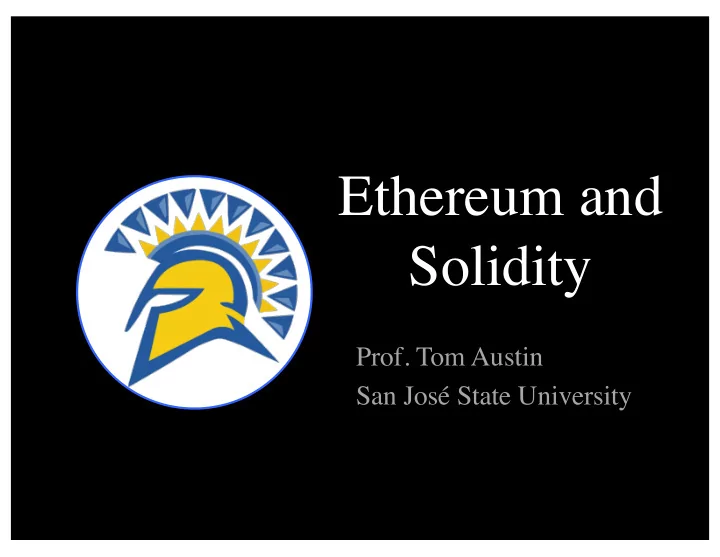

Ethereum and Solidity Prof. Tom Austin San José State University
Bitcoin (BTC) • Protocol designed by Satoshi Nakamoto in 2008 https://bitcoin.org/bitcoin.pdf • First Bitcoin client launched in 2009 • Peer-to-peer – no centralized control – Every client keeps track of the history of all bitcoins
Bitcoin "Script" Language • Forth-like – Reverse-Polish notation – Stack based • Lock: scriptPubKey • Unlock: scriptSig • https://en.bitcoin.it/wiki/Script
Sample Transaction Output "vout": [ { "value": 0.01500000, "scriptPubKey": "OP_DUP OP_HASH160 ab6802… OP_EQUALVERIFY OP_CHECKSIG" }, { "value": 0.08450000, "scriptPubKey": "OP_DUP OP_HASH160 7f9b1a… OP_EQUALVERIFY OP_CHECKSIG" }, ]
Sample Script 2 7 OP_ADD 3 OP_SUB 1 OP_ADD 7 OP_EQUAL (in-class)
Sample Script Pay-to-public-key-hash (P2PKH) <sig> <PubK> DUP HASH160 <PubKHash> EQUALVERIFY CHECKSIG (in-class)
Script Limitations • No loops. • No complex control flow. • Not Turing complete. • No division.
Ethereum • Smart contracts for building distributed applications (dApps). • Almost Turing complete. – "Gas" to pay for computation.
Some Brief Ethereum Facts • Number 2 cryptocurrency by market cap. • Core developers – Vitalik Buterin (creator) – Gavin Wood • Block 0 mined July 30, 2015
Account Types • Externally owned accounts (EOAs) – Have a private key • Contract accounts – Have contract code – No private key • Cannot initiate transactions – Can react to transactions and call other contracts – Contain data
Common Features with Bitcoin • Digital currency – Called ether (ETH) • Not "ethereum" – Smallest unit: wei • Proof-of-work blockchain – Ethash – designed to be ASIC-resistant – Much quicker: 14-15 second block time – Plans to move to proof-of-stake (Casper) • Peer-to-peer network
Differences from Bitcoin • Quasi-Turing complete virtual machine – Brings up a lot of security issues • Gas – Prevents denial-of-service attacks – Transactions specify: • ETH earmarked for gas • gas-rate
Lab, Part 1 Create Ethereum MetaMask wallet. Details in Canvas.
Decentralized Applications (DApps) • Also referred to as dApps, Dapps, and Ð Apps – Ð is the Old-English letter 'Eth' • Written in a smart contract language – Solidity is the most prevalent
Smart Contracts
Smart Contracts (Definition from Mastering Ethereum ) Immutable computer programs that run deterministically in the context of an Ethereum Virtual Machine as part of the Ethereum network protocol—i.e., on the decentralized world computer.
Smart Contract Life Cycle 1. Published to the zero address . – 0x0000000000000000000000000000000000000000 – Author has no special rights to a contract, unless the contract is written that way. 2. Invoked by transaction. 3. May be destroyed. – Only if creator configured it that way.
High-level Languages for EVM • LLL – Lisp-like language. – Oldest, but rarely used. • Serpent – Python-ish • Solidity – JavaScript-ish • Vyper – Also Python-ish • Bamboo – Erlang-ish
High-level Languages for EVM • LLL – Lisp-like language. – Oldest, but rarely used. • Serpent – Python-ish • Solidity – JavaScript-ish • Vyper – Also Python-ish • Bamboo – Erlang-ish
Solidity • Created by Gavin Wood. • Most popular HLL for Ethereum today.
Solidity Data Types (not exhaustive) • bool • int , uint – Variants in 8, 16, 32, …, 256 – Default is 256 • fixed , ufixed • address • Arrays • Time units • Ether units: wei , finney , szabo , and ether
Global Variables • msg – the transaction call. – Fields: sender, value, gas, data, sig • tx – the transaction. – Fields: gasprice • block – the block the transaction is in. – Fields: coinbase, difficulty, gaslimit, number, timestamp (in seconds since epoch)
Constructing and Destroying Contracts • Created with constructor . – Older versions used contract name • Destroyed with selfdestruct . – Person who destroys it claims the contract's ether. – Only if enabled by author.
Function Syntax function FunctionName ([ parameters ]) {public|private|internal|ex ternal} [pure|constant|view|payable ] [ modifiers ] [returns ( return types )]
Function Modifiers • Functions that modify other functions • Use an underscore (_) as a placeholder for the modified function modifier onlyOwner { require (msg.sender == owner); _; }
Function Restricting Access function takeFunds(amt) public { require (msg.sender == owner); msg.sender.transfer(amt); }
Using Function Modifier function takeFunds(amt) public onlyOwner { msg.sender.transfer(amt); }
Error handling • Guarantee state. – Throw an exception if false. • assert – Used only to catch internal programming errors • require – Used to validate external input – May be given 2 nd argument for better error handling
Review Test Faucet Contract (in-class)
Suggested Reading • The Beige Paper – https://github.com/chronaeon/beigepaper/blob/master/beige paper.pdf – Less formal version of the Yellow Paper (https://ethereum.github.io/yellowpaper/paper.pdf) • Mastering Ethereum, by Andreas M. Antonopoulos and Gavin Wood. https://github.com/ethereumbook/ethereumbook – Many of the examples from today taken from this book
Lab: Distributed Lottery in Ethereum There can be exactly 3 players. Each player contributes ether and pick a random number. Once the last player has contributed, the winner's address is selected. The winner can then destroy the smart contract to claim the winnings. More details in Canvas.
Recommend
More recommend